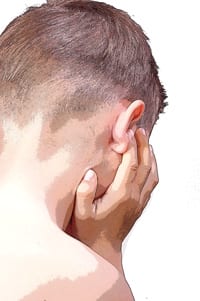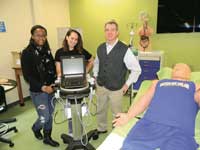Drugs or No Drugs? That Is Often the Question When It Comes to a Child’s Ear Pain
Nobody likes to see their child in pain, and that is why many parents bring their children to my office to see me if they have an ear infection. Most parents can care for a simple cold or a low-grade fever at home, but when their young ones get fussy and start pulling on their ears, it is often time to come in to see if they have an ear infection.
A middle-ear infection, also referred to as acute otitis media (AOM), is one of the most common bacterial illnesses in children. It is estimated that half of all children under the age of 1 will experience an ear infection, increasing to 75{06cf2b9696b159f874511d23dbc893eb1ac83014175ed30550cfff22781411e5} before age 3. Each year, earaches send millions of parents — many of whom have spent a long night without sleep trying to calm their crying child — to the pediatrician.
Those parents often hear grandma telling them that their child needs antibiotics because “that’s how it was done in my day.” But things have changed since grandma asked for, or even sometimes demanded, antibiotics. Improved vaccines now protect children from the bacteria that caused meningitis and other serious infections when grandma was raising her own children. The good news is that now, most fully vaccinated children recover from ear infections on their own within two or three days without antibiotics.
New Guidelines
The American Academy of Pediatrics (AAP) has issued new evidence-based guidelines for the treatment of uncomplicated AOM in children 6 months through 12 years old. The new guidelines attempt to expand upon and further clarify the AAP’s recommendations from 2004, which suggested that ‘watchful waiting’ was best before prescribing antibiotic treatment.
According to the academy, the new guidelines offer “more stringent criteria to use in making an accurate diagnosis of AOM, enabling clinicians to prescribe antibiotics most effectively.” The guidelines also include recommendations for treatment with antibiotics and pain relievers, or observation alone, based on the child’s age and severity of symptoms.
Rather than going right to prescribing antibiotics, today’s parents and pediatricians should ask, “does the child really need antibiotics, or can we wait a day or two to see how things develop?” The answer to that question depends on the child’s age, how sick the child is, and how the eardrum appears on exam. If the child appears ill, has a high fever, and is in severe pain from a red and bulging eardrum, antibiotics should be started. Any child 6 months to 2 years old with infections in both ears, or with a ruptured eardrum from an acute infection, should also be given antibiotics.
For those vaccinated children without severe signs of infection, watchful waiting may be a better option than starting antibiotics right away. Since many of these children will recover from their ear infection without antibiotics, watchful waiting prevents the expense and the side effects of unnecessary antibiotics. I tell parents not to rush into starting antibiotics for their child’s earache, since the side effects of antibiotics can sometimes be worse than the original ear discomfort. Antibiotics can cause an upset stomach, diarrhea, and various allergic reactions. If the child isn’t getting any better within 72 hours of watchful waiting, administering antibiotics may be necessary.
Many children experience ear pain without having a bacterial ear infection. We all have a Eustachian tube which connects the back of the throat to the middle ear. Children with colds often have post-nasal drip that will clog the small opening of that tube. This can cause pressure or fluid to build up in the ear, which in turn may cause discomfort to the child.
Every time I fly on an airplane, I feel the same pressure and pain that my patients experience with their colds. I know that my discomfort is not caused by a bacterial infection, but by pressure in my middle ear. So, instead of reaching for the antibiotics, I know that a little ‘tincture of time’ and some saline to clear my sinuses are all that I need for my pain to resolve. That is the same prescription I recommend for my patients with colds who may be tugging on their ears due to pressure and not infection.
For a child with ear pain from any cause, it is important to treat the discomfort that is causing distress to the child, as well as their parents. Ibuprofen, acetaminophen, or, in some cases, ear drops can be given to treat the pain.
By limiting the prescribing of antibiotics to only those children with severe ear infections, we help prevent the overuse of antibiotics, which is a leading cause of antibiotic-resistant bacteria in this country.
In August, my colleague at Baystate Children’s Hospital, Dr. John Snyder, wrote a column for HCN titled “Prescription for Trouble: It’s Time to Stop the Overuse and Misuse of Antibiotics with Children.” This column perfectly sums up the dilemma. The more we use an antibiotic, the more we allow resistant organisms to multiply and spread among our population. The overuse of antibiotics and the resulting spread of resistant organisms can lead to serious or even catastrophic consequences — all because increasing antibiotic resistance makes it more difficult to find an appropriate antibiotic that will work for a given infection.
Preventative Steps
Also of importance, the new guidelines offer parents useful information on the best ways to protect their child from a painful ear infection. These include maintaining a tobacco-free home and keeping children away from passive tobacco smoke, and breastfeeding your new baby for at least six months; studies have shown the natural practice to be effective in reducing the number of earaches a child will experience.
Even with our better vaccines, ear infections will remain a part of life for infants and their parents. Pediatricians and parents should work together to minimize unnecessary antibiotics while helping children with ear infections heal and be pain-free. The next time your child is pulling on his or her ears, before you ask for an antibiotic prescription, have a conversation with your pediatrician about whether that is the best thing for your child.
For those wishing to review the academy’s recommendations in depth, “The Diagnosis and Management of Acute Otitis Media” was published in the March 2013 issue of Pediatrics and released online Feb. 25.
Dr. John O’Reilly is a pediatrician with Baystate General Pediatrics and Baystate Children’s Hospital; baystatehealth.org/



